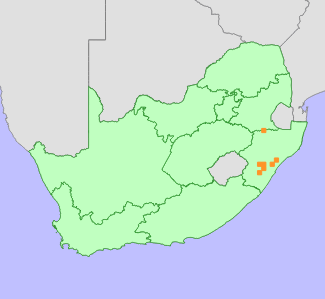|
Scientific Name | Dierama nixonianum Hilliard |
Higher Classification | Monocotyledons |
Family | IRIDACEAE |
National Status |
Status and Criteria | Vulnerable B1ab(ii,iii,iv)+2ab(ii,iii,iv) |
Assessment Date | 2014/08/05 |
Assessor(s) | C.R. Scott-Shaw, L. von Staden & I.M. Johnson |
Justification | The grassland habitat of this species has been extensively transformed to sugarcane cultivation, forestry plantations, subsistence farming and severe overgrazing. There is less than 1000 km² of its mistbelt grassland habitat left, and between five and seven locations are likely to remain. The subpopulation at the type locality is locally extinct, and many other subpopulations may also be declining or locally extinct. One subpopulation is about to be lost to a housing development. |
Distribution |
Endemism | South African endemic |
Provincial distribution | KwaZulu-Natal |
Range | KwaZulu-Natal Midlands and Wakkerstroom. |
Habitat and Ecology |
Major system | Terrestrial |
Major habitats | Midlands Mistbelt Grassland, Mooi River Highland Grassland, Moist Coast Hinterland Grassland, Paulpietersburg Moist Grassland |
Description | Open grassland over sandstone, 760-1500 m. |
Threats |
| In the KwaZulu-Natal Midlands, the grassland habitat of this species is extensively irreversibly modified to sugarcane plantations, forestry plantations, subsistence farming and severe overgrazing (transformation nearly 70% - calculated using GIS). The population at the type locality is locally extinct, and many others may also be declining or locally extinct due to excessive transformation of the areas where they were collected previously. One known subpopulation is about to disappear under a housing development.
An isolated record from northern KwaZulu-Natal is from an area that is not threatened. |
Population |
The population has been fragmented due to extensive habitat loss. Known remaining subpopulations predominantly occur on small remnants. Not enough survey data is yet available to estimate the size of the remaining population, but it is declining due to ongoing habitat loss and degradation. Three subpopulations known through historical records are now locally extinct due to habitat loss, and two more require surveys to determine whether they are still extant.
|
Population trend | Decreasing |
Conservation |
| Karkloof Nature Reserve. |
Assessment History |
Taxon assessed |
Status and Criteria |
Citation/Red List version | | Dierama nixonianum Hilliard | VU B2ab(ii,iii,iv) | 2015.1 | | Dierama nixonianum Hilliard | EN B2ab(ii,iii,iv) | Raimondo et al. (2009) | | Dierama nixonianum Hilliard | VU | Scott-Shaw (1999) | | Dierama nixonianum Hilliard | Rare | Hilton-Taylor (1996) | |
Bibliography |
Hilliard, O.M. and Burtt, B.L. 1991. Dierama: The hairbells of Africa. Acorn Books, Johannesburg and London.
Hilton-Taylor, C. 1996. Red data list of southern African plants. Strelitzia 4. South African National Botanical Institute, Pretoria.
Mucina, L. and Rutherford, M.C. (eds). 2006. The vegetation of South Africa, Lesotho and Swaziland. Strelitzia 19. South African National Biodiversity Institute, Pretoria.
Raimondo, D., von Staden, L., Foden, W., Victor, J.E., Helme, N.A., Turner, R.C., Kamundi, D.A. and Manyama, P.A. 2009. Red List of South African Plants. Strelitzia 25. South African National Biodiversity Institute, Pretoria.
Scott-Shaw, C.R. 1999. Rare and threatened plants of KwaZulu-Natal and neighbouring regions. KwaZulu-Natal Nature Conservation Service, Pietermaritzburg.
|
Citation |
| Scott-Shaw, C.R., von Staden, L. & Johnson, I.M. 2014. Dierama nixonianum Hilliard. National Assessment: Red List of South African Plants version . Accessed on 2025/09/16 |
 Comment on this assessment
Comment on this assessment


